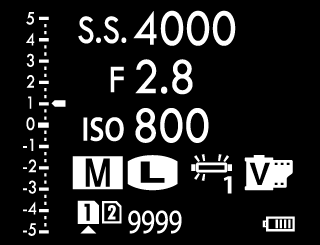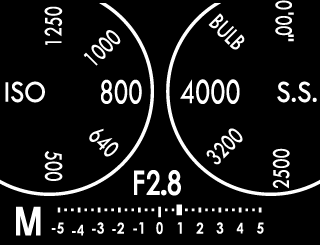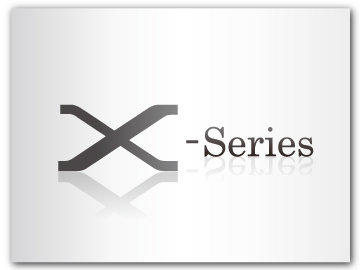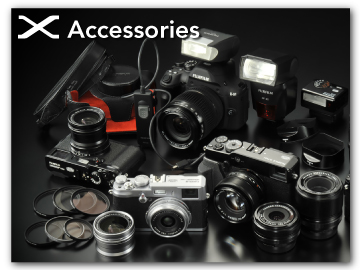Camera Displays
This section lists the indicators that may be displayed during shooting.
For illustrative purposes, displays are shown with all indicators lit.
- The Electronic Viewfinder
- The LCD Monitor
- Choosing a Display Mode
- Adjusting Display Brightness
- Display Rotation
- The DISP/BACK Button
- The Dual Display
- Customizing Display Indicators
- Virtual Horizon
- The Secondary LCD Monitor
The Electronic Viewfinder
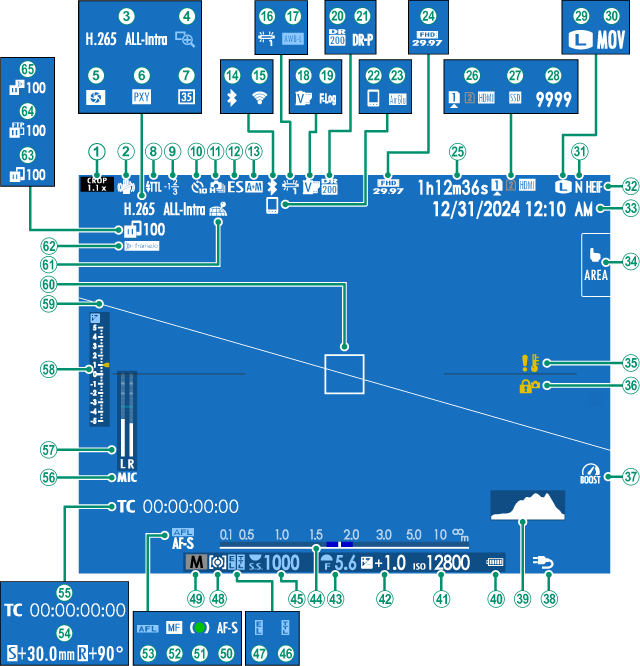
ACrop factor
BIS mode 2
CMovie compression
DFocus check
EDepth-of-field preview
FProxy setting (ProRes only)
G35mm format mode
HFlash (TTL) mode
IFlash compensation
JSelf-timer indicator
KContinuous mode
LShutter type
MAF+MF indicator 2
NBluetooth ON/OFF
OWireless connection
PWhite balance
QAWB lock
RFilm simulation
SF-Log/HLG recording
TDynamic range
UD-range priority
VBluetooth host
WAirGlu BT connection
XMovie mode
YRecording time available/
elapsed recording time
ZCard slot options
aSSD connection status
bNumber of available frames 1
cImage size
dFile format
eImage quality
fHEIF format
gDate and time
hTouch screen mode
iTemperature warning
jControl lock 3
kBoost mode
lPower supply
mHistogram
nBattery level
oSensitivity
pExposure compensation
qAperture
rDistance indicator 2
sShutter speed
tTTL lock
uAE lock
vMetering
wShooting mode
xFocus mode 2
yFocus indicator 2
zManual focus indicator 2
0AF lock
1Shift amount/rotate amount
2Time code
3Microphone input channel
4Recording level 2
5Exposure indicator
6Virtual horizon
7Focus frame
8Location data download status
9Frame.io connection status
AImage transfer status
BFTP upload progress
CFrame.io upload progress
Shows “9999” if there is space for over 9999 frames.
Not displayed when ON is selected for DSCREEN SET-UP > LARGE INDICATORS MODE(EVF).
Displayed when controls have been locked by pressing and holding the MENU/OK button. Control lock can be ended by pressing and holding the MENU/OK button again.
The LCD Monitor
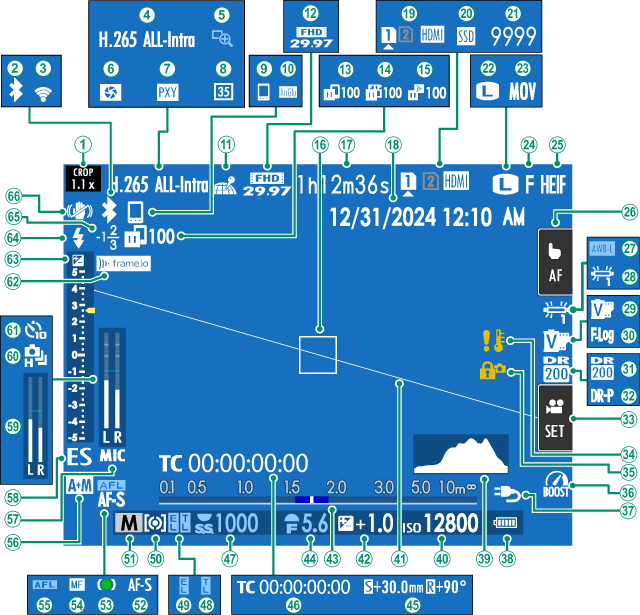
ACrop factor
BBluetooth ON/OFF
CWireless connection
DMovie compression
EFocus check
FDepth-of-field preview
GProxy setting (ProRes only)
H35mm format mode
IBluetooth host
JAirGlu BT connection
KLocation data download status
LMovie mode
MImage transfer status
NFTP upload progress
OFrame.io upload progress
PFocus frame
QRecording time available/
elapsed recording time
RDate and time
SCard slot options
TSSD connection status
UNumber of available frames 1
VImage size
WFile format
XImage quality
YHEIF format
ZTouch screen mode 3
aAWB lock
bWhite balance
cFilm simulation
dF-Log/HLG recording
eDynamic range
fD-range priority
gMovie optimized control 3
hTemperature warning
iControl lock 4
jBoost mode
kPower supply
lBattery level
mHistogram
nSensitivity
oVirtual horizon
pExposure compensation
qDistance indicator 2
rAperture
sShift amount/rotate amount
tTime code
uShutter speed
vTTL lock
wAE lock
xMetering
yShooting mode
zFocus mode 2
0Focus indicator 2
1Manual focus indicator 2
2AF lock
3AF+MF indicator 2
4Microphone input channel
5Shutter type
6Recording level 2
7Continuous mode
8Self-timer indicator
9Frame.io connection status
AExposure indicator
BFlash (TTL) mode
CFlash compensation
DIS mode 2
Shows “9999” if there is space for over 9999 frames.
Not displayed when ON is selected for DSCREEN SET-UP > LARGE INDICATORS MODE(LCD).
Camera functions can also be accessed via touch controls.
Displayed when controls have been locked by pressing and holding the MENU/OK button. Control lock can be ended by pressing and holding the MENU/OK button again.
Choosing a Display Mode
Press the VIEW MODE button to cycle through the following display modes. You can choose separate display modes for shooting and playback.
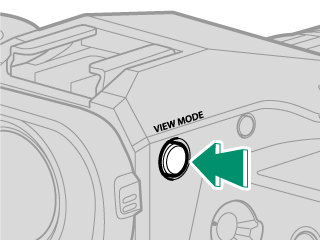
Use DSCREEN SET-UP > VIEW MODE SETTING in the setup menu to choose a display mode for the EVF and LCD monitor.
SHOOTING
| Option | Description |
|---|---|
| EEYE SENSOR | Putting your eye to the viewfinder turns the viewfinder on and the LCD monitor off; taking your eye away turns the viewfinder off and LCD monitor on. |
| rLCD ONLY | LCD monitor on, viewfinder off. |
| QEVF ONLY | Viewfinder on, LCD monitor off. |
| QEVF ONLY + E | Putting your eye to the viewfinder turns the viewfinder on; taking it away turns the viewfinder off. The LCD monitor remains off. |
| tEYE SENSOR + LCD IMAGE DISP. | Putting your eye to the viewfinder during shooting turns the viewfinder on, but the LCD monitor is used for the display of images once you remove your eye from the viewfinder after shooting. The options selected for DSCREEN SET-UP > IMAGE DISP. apply to display in the LCD monitor. This setting cannot be selected while shooting movies. |
Go to DSCREEN SET-UP > VIEW MODE SETTING > SHOOTING in the setup menu and press the Q button to choose the view modes available.
PLAYBACK
| Option | Description |
|---|---|
| EEYE SENSOR | Putting your eye to the viewfinder turns the viewfinder on and the LCD monitor off; taking your eye away turns the viewfinder off and LCD monitor on. |
| rLCD ONLY | LCD monitor on, viewfinder off. |
| QEVF ONLY | Viewfinder on, LCD monitor off. |
The Eye Sensor
- The eye sensor may respond to objects other than your eye or to light shining directly on the sensor.
- The eye sensor is not available when the LCD monitor is tilted.
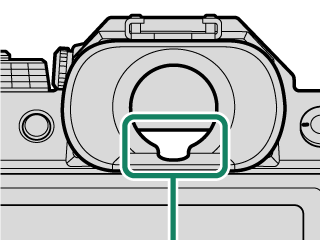
Eye sensor
Adjusting Display Brightness
The brightness and saturation of the viewfinder and LCD monitor can be adjusted using the items in the DSCREEN SET-UP menu. Choose EVF BRIGHTNESS or EVF COLOR to adjust viewfinder brightness or saturation, LCD BRIGHTNESS or LCD COLOR to do the same for the LCD monitor.
Display Rotation
When ON is selected for DSCREEN SET-UP > AUTOROTATE DISPLAYS, the indicators in the viewfinder and LCD monitor automatically rotate to match camera orientation.
The DISP/BACK Button
The DISP/BACK button controls the display of indicators in the viewfinder and LCD monitor.

Indicators for the EVF and LCD must be selected separately. To choose the EVF display, place your eye to the viewfinder while using the DISP/BACK button.
Viewfinder
The dual display is available only when shooting still images with manual focus.
LCD monitor
The dual display is available only during manual focus.
The Dual Display
The dual display consists of a large full-frame window and a smaller close-up of the focus area.
Customizing Display Indicators
Use DSCREEN SET-UP > DISP. CUSTOM SETTING to select the items shown in the full screen and standard indicators displays.
-
Select DISP. CUSTOM SETTING.
Select DSCREEN SET-UP > DISP. CUSTOM SETTING in the setup menu.
-
Choose items.
Highlight items and press MENU/OK to select or deselect.
- FRAMING GUIDELINE
- FOCUS FRAME
- FOCUS INDICATOR
- AF DISTANCE INDICATOR
- MF DISTANCE INDICATOR
- HISTOGRAM
- LIVE VIEW HIGHLIGHT ALERT
- SHOOTING MODE
- APERTURE/S-SPEED/ISO
- INFORMATION BACKGROUND
- Expo. Comp. (Digit)
- Expo. Comp. (Scale)
- FOCUS MODE
- PHOTOMETRY
- SHUTTER TYPE
- FLASH
- CONTINUOUS MODE
- DUAL IS MODE
- TOUCH SCREEN MODE
- WHITE BALANCE
- FILM SIMULATION
- DYNAMIC RANGE
- BOOST MODE
- SHIFT AMOUNT OF T/S LENS
- ROTATE AMOUNT OF T/S LENS
- FRAMES REMAINING
- IMAGE SIZE/QUALITY
- MOVIE MODE & REC. TIME
- 35mm FORMAT MODE
- COMMUNICATION STATUS
- MIC LEVEL
- GUIDANCE MESSAGE
- NO STORAGE MEDIA WARNING
- DATE/TIME
- BATTERY LEVEL
- FRAMING OUTLINE
-
Press DISP/BACK to save changes.
Framing Outline
Enable FRAMING OUTLINE to make the borders of the frame easier to see against dark backgrounds.
Histograms
Histograms show the distribution of tones in the image. Brightness is shown by the horizontal axis, the number of pixels by the vertical axis.
|
Number of pixels
|
|
|
Shadows |
Pixel brightness |
|
Optimal exposure: Pixels are distributed in an even curve throughout the tone range.

Overexposed: Pixels are clustered on the right side of the graph.

Underexposed: Pixels are clustered on the left side of the graph.

To view separate RGB histograms and a display showing areas of the frame that will be overexposed at current settings superimposed on the view through the lens, press the function button to which HISTOGRAM is assigned (aFunction Controls).
AOverexposed areas blink
BRGB histograms
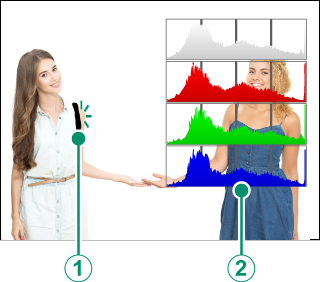
Virtual Horizon
Check whether the camera is level. The display type can be chosen using DSCREEN SET-UP > ELECTRONIC LEVEL SETTING. Use the virtual horizon to level the camera when mounting it on a tripod or the like.
2D
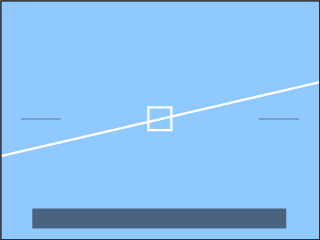
3D
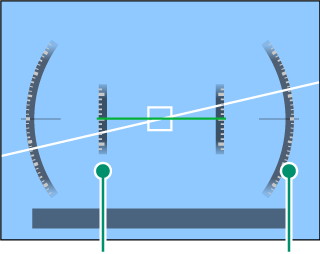
Pitch Roll
- OFF: The virtual horizon is not displayed.
- 2D: A white line shows the amount the camera is tilted left or right. The line turns green when the camera is level. The line may vanish if the camera is tilted forward or back.
- 3D: The display shows whether the camera is tilted left or right and forward or back.
ELECTRONIC LEVEL SWITCH can be assigned to a function button and the button then used to switch between the 2D and 3D displays.
The Secondary LCD Monitor
Among the settings that can be viewed in the secondary LCD monitor are shutter speed, aperture, and ISO sensitivity.

Secondary LCD monitor
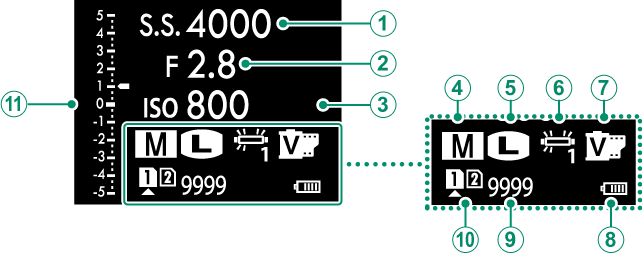
| Default | |
|---|---|
ASHUTTER SPEED |
GFILM SIMULATION |
BAPERTURE |
HBATTERY LEVEL |
CISO |
IFRAMES REM. |
DSHOOTING MODE |
JCARD SLOT OPTIONS |
EIMAGE SIZE * |
KdScale |
FWHITE BALANCE |
|
* Changed to MOVIE MODE in movie mode.
The settings displayed can be selected using DSCREEN SET-UP > SUB MONITOR SETTING.
Cycling Through Indicators in the Secondary LCD Monitor
The indicators displayed in the secondary LCD monitor change each time the secondary LCD monitor mode button is pressed.
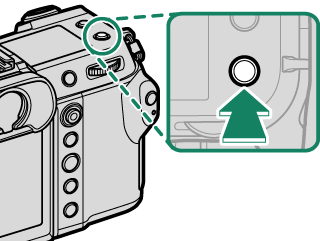
The Secondary Monitor Backlight Button
To turn on the secondary LCD monitor backlight when you find the secondary LCD monitor too dark to read, press the secondary monitor backlight button. Press the button again to turn the backlight off.
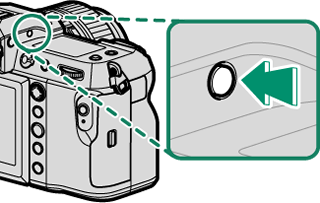
Background Color
The background color (black or white) for the secondary LCD monitor can be selected using the DSCREEN SET-UP > SUB MONITOR BACKGROUND COLOR option in the D (setup) menu. Note that the background is displayed in white whenever the secondary LCD monitor backlight is on.

 .
.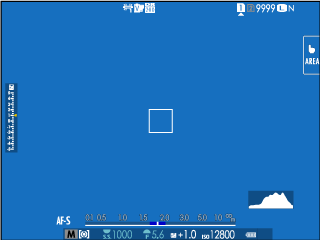

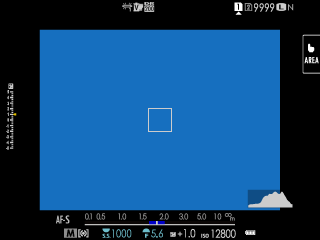


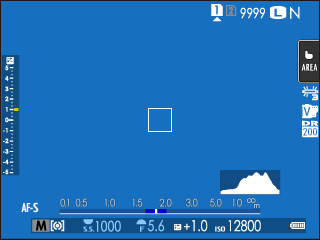
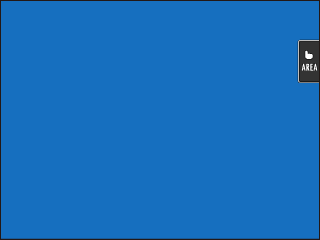
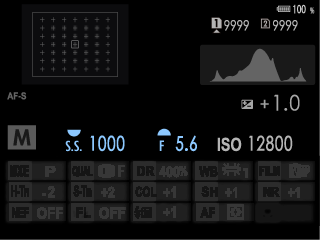
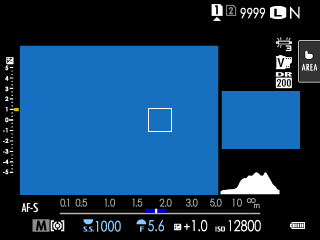



 Highlights
Highlights